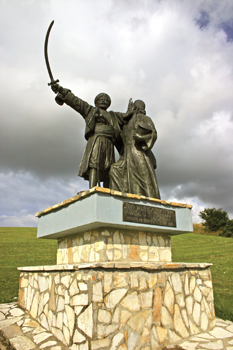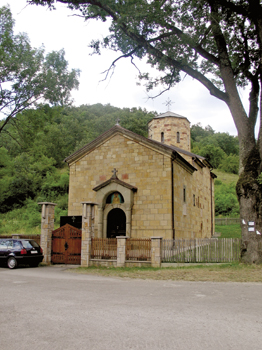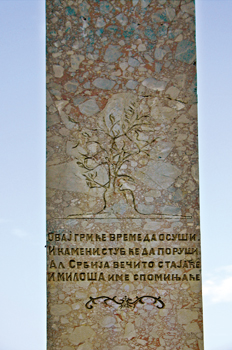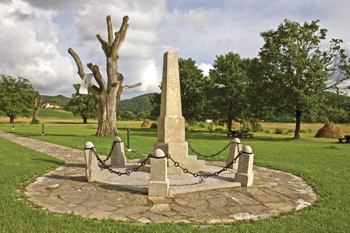Sources
“NATIONAL REVIEW” IN THE TAKOVO AREA
Following the Trails of Modern Serbia
Just as Orašac, Viševac and Topola are important for the Karađorđević dynasty and the First Serbian Uprising, the villages in the community of Gornji Milanovac are important for the Obrenović dynasty. Our reporter have visited the place where the future Prince spent his longest night before the uprising, where St. Sava woke up water from rocks with his magic stick, where Vuk Karadžić admired the beauty of the new built church, not knowing that it shall keep the grave of his daughter
By: Vlada Arsić
 Only ten kilometers away from Gornji Milanovac, on the road that leads from Brusnica to Ravna Gora and villages at the bottom of Maljen, lays Takovo. We know many things about the place where the Serbs have upraised against the Turks for the second time. There are many documents, many appropriate speeches, but it was hard to reach it. It seems that those several thousands of meters, which is how far it is from the Ibar Highway, were always the obstacle for those who were rushing to the seaside and not care much for Serbian history. Only ten kilometers away from Gornji Milanovac, on the road that leads from Brusnica to Ravna Gora and villages at the bottom of Maljen, lays Takovo. We know many things about the place where the Serbs have upraised against the Turks for the second time. There are many documents, many appropriate speeches, but it was hard to reach it. It seems that those several thousands of meters, which is how far it is from the Ibar Highway, were always the obstacle for those who were rushing to the seaside and not care much for Serbian history.
Traveling through this area, the reporters of National Review visited Vraćevšnica, the monastery on Rudnik, on the way to Gornji Milanovac, towards Kragujevac. We arrived to the endowment of the Great Chief Radič Postupovič before the vesper service, when visitors are not very desirable. We found the rushed sisterhood, murmur, and tumult. Like in a beehive, the nuns rushed to finish their tasks and then to dedicate themselves to prayer in silence. However, they welcomed us appropriately. They served us coffee, brandy, strawberry preserves, and ice-cold water. We talked about the monastery and the story lead us to the long gone night when Miloš Obrenović, on the day when the Second Serbian Uprising was proclaimed, came here with his men. The agreement on the uprising was already finished, and it was only left to reveal it tomorrow, to the people.
What were the young commander's thoughts? Was it one of his longest nights, as we suppose?
UPRISING, THE END AND THE BEGINNING
For Miloš, Vraćevšnica always had a special importance. According to the story of Nun Gavrila, our host, his wish was to gather all members of the Obrenović family here. First, he brought his mother's body, and then he buried some of his children in the churchyard. Unfortunately, he never had a chance to make his mausoleum of it, as for the other members of the Karađorđević dynasty. The Obrenovićs are left scattered all over Serbia, from Krušedol to Rakovica, from Belgrade to Brusnica. There is one more thing that makes Vraćevšnica so special. It is said that Karađorđe gathered commanders in its churchyard, and announced them the decisions of the Treaty of Bucharest. That peace was not good for the Serbian people. The Turks have broken the uprising, but fate wanted that the flag of freedom rises again, only two years later.
On a holiday Cveti in 1815, at dawn, Miloš left for Takovo on his horse. He was on a horse, and we are in a car, two centuries later. Takovo is so different from Orašac, its eternal rival on a scale of historical places and events! There are no forests, no ravines, no hidden glances, and no secure strongpoints. No fear that the uprisers will be noticed or preventing in their plans, in any way. We do not think that anyone noticed, in the time of battles, what we are looking at today with admiration. The divine beauty is all around, there are streams and orchards, fields, meadows, pastures. There are not many people, but if you stop somewhere, they will welcome you with a smile. They are not very wealthy but they shall be happy to split with you what God and the fertile soil gave them.
The log cabin church in front of which we have arrived dates from the end of the 18th century. It was built on a hill above the village, surrounded by high grass, old oak trees, and even older tombstones. The door is locked, there is no regular service, but Ljubiša Milić, the local priest says that on Todor's Saturday, Cveti and other holidays, the holy liturgy is kept in it. The people gathers, they pray to God and they take Communion, and then they go a hundred meters lower, to the place where the Serbs have upraised against the Turks for the second time.
ABOUT CASTLES AND OBLIVION
 If you are on an excursion or a member of an organized group maybe, you can enter the building of the former school, the endowment of King Aleksandar Obrenović, turned into a museum. Unfortunately, if you are coming unannounced, which happened to us, the door of the museum would be closed, so you will not have a chance to see the most interesting details of the area. If you are on an excursion or a member of an organized group maybe, you can enter the building of the former school, the endowment of King Aleksandar Obrenović, turned into a museum. Unfortunately, if you are coming unannounced, which happened to us, the door of the museum would be closed, so you will not have a chance to see the most interesting details of the area.
Fortunately, we met Ljubiša Jovanović on the way, our colleague from Takovske Novine (Newspapers of Takovo), who lives here since birth. He knows much about the history of Takovo, he wrote a lot about it. For the story he will give us, he made a condition. We must come to his place, taste his plum brandy, and if we still feel like talking, he shall help us. He says that that is the local custom, so it is not right to argue. Moreover, the story would flow with some brandy. Among many stories and legends, the most interesting one was about the torn down castle of the Obrenović dynasty.
The castle of Takovo was built after the wish of Queen Draga Obrenović and the people complained and cursed – says Jovanović. – The tortured and poor people brought the material from all sides: stone and sand from Morava River, lime from Dragačevo, other building material from Zlatibor. When it was finished in september of 1902, the castle had 36 rooms, a pool hall, many salons... the royal couple attended the opening, but they never spent the night. Draga and Aleksandar were killed next year, and after their death, the castle was neglected. The property was taken, sold, and resold, and in 1917, the building was burned in a fire. Only memories, a few stones, and yellowish photographs remained of the former luxury.
While we are looking at the wasteland where the beautiful building was placed, we say: if this castle were built somewhere in Scotland or on Loire, today it would be the tourist center, along with its history and legend. However...
We continue our voyage towards Savinac, a hamlet four kilometers from Šarani village, for which Jovanović said we had to see. And we shall understand why when we arrive.
SAINT SAVA AND HEALING WATER
 According to a belief, St. Sava passed through this area in the 13th century, intending to consecrate the new built monastery on the nearby hill Glavica. Riding his horse, he reached Dičina River, where he stopped to admire the beauty of the small river waterfall. “Let this beauty be miraculous”, said St. Sava and stroke his sacred stick on a massive rock from which a spring of clear and cold water came out. At the same time, Sava's horse left deep traces with his hooves in this rock, which can still be seen when the water level is low. After the consecration of the monastery and the religious service, St. Sava got back to Dičina, consecrated the spring and the water. According to a belief, St. Sava passed through this area in the 13th century, intending to consecrate the new built monastery on the nearby hill Glavica. Riding his horse, he reached Dičina River, where he stopped to admire the beauty of the small river waterfall. “Let this beauty be miraculous”, said St. Sava and stroke his sacred stick on a massive rock from which a spring of clear and cold water came out. At the same time, Sava's horse left deep traces with his hooves in this rock, which can still be seen when the water level is low. After the consecration of the monastery and the religious service, St. Sava got back to Dičina, consecrated the spring and the water.
There are similar stories about St. Sava in other parts of Serbia. However, the fact that Dičina has healing springs is true, between which Mlačac and Svetinja, springs near the church, which are called Sava's springs. The research has shown that this water has 23 chemical elements, and registration plates of cars that come here are of Kraljevo, Čačak, Milanovac, Belgrade, and other towns tell us that the water really helps or people believe its powers. The residents say that people come all the way from Novi Sad, the bathe, wash their faces and take the water. It is believed that Svetinja helps with eye diseases, and that the water from Mlačac helps with the blood pressure, rheumatic pain and mentally disturbed persons. Truly, when you hear the river gurgling, inhale the clean air and look at the forest around you, we believe that nervousness disappears without the water.
We heard another story, probably the true one, from Milivoje Zdravković, the resident and the good connoisseur of the history of this area. The story says that Prince Miloš and his older brother Milan once stopped to rest here. They admired the beauties of the area and Milan said:
“You know, Miloš, if God enabled me to make some money, I would build a church here, on this beautiful place, right by the water.”
Commander Milan Obrenović died during the First Serbian Uprising, and Miloš remembered his brother's words. When the battles stopped and when Serbia was liberated, he decided to build an endowment church, for his brother Milan.
THE PEACE OF THE ENDOWMENT
 Miloš's endowment was finished and consecrated in 1821 and it became the family mausoleum of the Obrenović family and the Vukomanović family, the family of Princess Ljubica. In the mausoleum under the church, also rest Obren Martinović, the father of Commander Milan and the first husband of Miloš's mother; Kruna, the wife of Master Jovan Obrenović; Radoslav and Marija, the parents of princess Ljubica and other members of the family. However, the attention of visitors will be attracted by the grave of Mina Vukomanović, the daughter of Vuk Karadžić and the widow of Aleksa Vukomanović, the professor of history Serbian literature and philology in Belgrade, the close relative of the holy Princess. Miloš's endowment was finished and consecrated in 1821 and it became the family mausoleum of the Obrenović family and the Vukomanović family, the family of Princess Ljubica. In the mausoleum under the church, also rest Obren Martinović, the father of Commander Milan and the first husband of Miloš's mother; Kruna, the wife of Master Jovan Obrenović; Radoslav and Marija, the parents of princess Ljubica and other members of the family. However, the attention of visitors will be attracted by the grave of Mina Vukomanović, the daughter of Vuk Karadžić and the widow of Aleksa Vukomanović, the professor of history Serbian literature and philology in Belgrade, the close relative of the holy Princess.
There are two wooden bell towers in the churchyard, almost two centuries old, and several porches whose purpose would be unknown for many people. Moreover, they are former wooden buildings made by rich families to keep their things in them or host their friends and relatives. They usually had two rooms, one in the ground floor and the second on the first floor. Having these porches in the churchyard or monastery yard was an important status symbol. It is interesting that these porches always belonged to the members of the family.
Except for the people who come here for healing springs, rare adventurists, hunters, and fishermen, the most frequent visitors of Savinac are weekend visitors from Gornji Milanovac. In the tourist organization of the community, they believe that this area could attract even more guests. About ten beautiful summer cottages, with beautiful lawns and small pools, which we saw by the bank of Dičina, would be a great lodging. However, a lot of effort and enthusiasm of tourist workers will be necessary for this area to affirm itself in the right way.
***
Bush
In the area of the historical monument-complex of the Second Serbian Uprising today we can see only a few monuments, an arranged lawn, paths with chandeliers, the copy of the flag from the uprising days and the bush of Takovo. However, the dried tree did not remember Miloš and his uprisers because Prince Mihailo planted it here, on the place of the former oak tree in 1867. They say that he wanted this wild bush to continue the life of his famous ancestor, and residents claim that it grew here until 1992.
***
To God and victory
According to another legend, the building of the church in Savinac is connected with healing springs. Namely, the legend says that a part of the army, after the uprising and the oath, went this way towards Ljubić. Prince Miloš washed his face and drunk the water from the spring and then he lied down under a European ash tree to rest. When he woke up, he said: “My brothers, this water helped me to get well as I wasn't feeling good for days. If we beat the Turks, I shall build a church here, to thank God and for our victory.”
***
Vuk and Mina
In the summertime of 1820, the unfinished church on Savinac was visited by Vuk Stefanović Karadžić, who was left speechless. He was so charmed by the beauty of the sacred place, as well as by the nature in the vicinities and he wrote the following in his notebook: “Savinac, in the area of Rudnik, on the left hill of Dičina River, near Rožanj Mountain, on a beautiful romantic place.” He could not even suspect that his daughter Mina, the Serbian painter and poet, would find her eternal peace in the very church, which dazzled him with its beauty.
|
